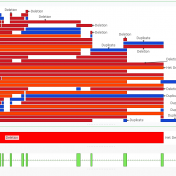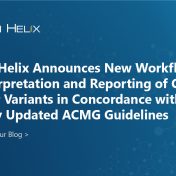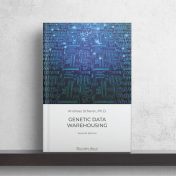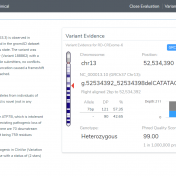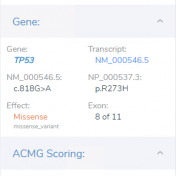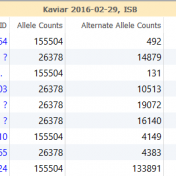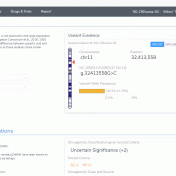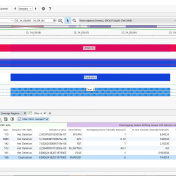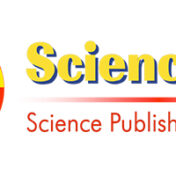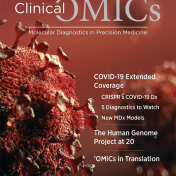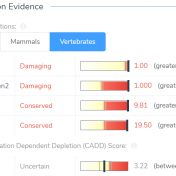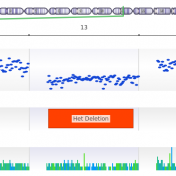Our software solutions and partners have brought dramatic improvements to the secondary and tertiary analysis stages of variant evaluation. Regarding secondary analysis, we’ve discussed increased efficiencies in speed and overall accuracy in the variant calling process with Sentieon. On the tertiary side, we have explored numerous workflows in VarSeq highlighting filtration to clinically relevant variants, as well as the automated… Read more »
The detection and interpretation of Copy Number Variants (CNVs) is vital for the clinical evaluation of individuals with a wide range of disorders. Golden Helix has remained at the forefront of CNVs in Next-Gen Sequencing (NGS) data since 2016 with the release of VS-CNV, our solution that allows you to both detect and analyze CNVs directly from NGS data. Earlier… Read more »
We’re excited to share the release of a newly updated resource from our CEO, Andreas Scherer, Ph.D. This morning, we published the Second Edition of his eBook, Genetic Data Warehousing, offering an in-depth exploration of how data warehousing technologies are shaping the future of clinical genomics and precision medicine. This updated edition reflects the growing complexity of managing genetic data… Read more »
It doesn’t take much effort to find articles discussing the value of Next-Generation Sequencing (NGS). There is a consistent tone amongst authors that implementing NGS pipelines are critical for clinical efficiency in both hereditary disorders and somatic. However, NGS strategies do not come without their own challenges. Challenges include not only the detection and calling of high quality/probability variants from… Read more »
Golden Helix has secured its reputation as a global leader in Next-Generation Sequencing (NGS) solutions for over two decades. Today, we are proud to announce that we have been included in the esteemed Inc. 5000 List of rapidly growing American companies. Out of the 6 million businesses in the United States, Golden Helix has been honored with a spot in… Read more »
The COVID-19 Pandemic ferociously spread across the globe bringing our daily lives to a quick halt – desks, streets, and towns nearly empty as our world united together to help “flatten the curve”. While most of us were introduced to remote work, medical workers from all different specialties were called upon to help treat and test COVID-19 patients. One long… Read more »
Golden Helix software provides huge analytic gain in handling large-scale genomic data. For example, a number of VarSeq users run cohort projects of whole genome level data processing hundreds of millions of variants at a time. However, many of our users are running gene panel level data for custom panels related to cancer (both hereditary and somatic), autism, cardiac, and… Read more »
In the search for disease causing mutations it is important to determine if the variant has been previously observed in humans and at what frequency. With the advent of increasing genomic information, there is now a variety of different databases and annotation sources that can be utilized. For some, this could be a tedious task that leads only to implementing… Read more »
In this month’s Customer Publications blog post, our VarSeq software is taking center stage! From whole exome sequencing to copy number variant calling, VarSeq can be used for a range of scientific investigations. Although this blog features several examples of cancer investigations in human patients, it’s interesting to see how this platform can be utilized in a variety of investigational… Read more »
It is common knowledge that variants can be germline or somatic depending on whether the variant was inherited or acquired after birth. A well-known example is cancer-causing mutations in the BRCA genes, wherein the mutation may or may not have been inherited. Understanding the origin of the cancer-causing mutation is important when assessing potential treatment options as well as identifying… Read more »
The world has been making a shift to use GRCh38 human genome reference coordinates, but the transition has not been fast. Many of the mainstay human catalog projects are changing to use native GRCh38 catalogs, or are remapping their current data to GRCh38 coordinates. While this seems to be the advancing goal, it is leaving researchers and analysts with the… Read more »
Thank you to everyone who joined our webcast, “Whole Genome Trait Association in SVS.” If you missed the live event and are interested in knowing what we talked about, you may access the recorded event below: Our Live Q&A generated a lot of great questions. Unfortunately, we were unable to answer them all, but we have compiled some of the… Read more »
Introduction: Malignant Rhabdoid tumors (MRT) are among the most aggressive and lethal forms of infant and child cancer (1). These tumors are characterized by an unusual combination of mixed cellular elements similar to but not typical of teratomas and can originate at any anatomic location. When MRTs are present in the brain, they are called atypical teratoid/rhabdoid tumors (AT/RT), which… Read more »
It is an honor to be published in the European Journal of Clinical and Biomedical Sciences (Volume 6, Issue 4) in an article co-authored by Dr. Christiane Scherer and myself, “Investigating the Global Spread of SARS-CoV-2 Leveraging Next-Gen Sequencing and Principal Component Analysis.” This study highlights how genomic surveillance of COVID-19 using Next-Generation Sequencing (NGS) can uncover transmission patterns and mutation… Read more »
Golden Helix has been incredibly fortunate to have been featured in a variety of publications over these last six months. Topics span from the history and future of our company to several new use cases for our solutions that extend into the infectious disease space, recently coming to fruition with the COVID-19 pandemic. We are so grateful to have received… Read more »
As I prepared to write the Customer Publication blog for June 2020, I was excited by the number of recently published papers that stood as examples of how both VarSeq and SVS software are employed to advance diagnostics and treatments in human medicine. We often think of SVS as the go-to platform for Agrigenomics, however both of our platforms have… Read more »
It is an honor to be featured in the Clinical OMICs May/June 2020 issue in a Q&A with the Editor discussing the past, present, and future of Golden Helix. In this article, I detail: Clinical OMICs Article: What has been Golden Helix’s most significant success or contribution to the industry over the past five years? Golden Helix started in 1998 with a… Read more »
The University of Washington’s Combined Annotation Dependent Depletion (CADD) algorithm, now available in CADD v1.4 and CADD v1.5, measures the deleteriousness of genetic variants. This includes single nucleotide polymorphisms (SNVs) and short insertions and deletions (indels) throughout the human reference genome assembly. This algorithm was introduced in 2014 and has since become one of the most widely used tools to assess human… Read more »
We have had many customers come to us over the years with a simple problem: they have BAM files for whole exome or gene panel data and would like to call CNVs using VarSeq’s powerful CNV calling capabilities, but they don’t have a bed file defining the target regions for their samples. To address this problem, we have developed a… Read more »
Abstract Before assessing the clinical significance of a somatic mutation, one must determine if the mutation is likely to be a driver mutation (i.e. a mutation that provides a selective growth advantage, thereby promoting cancer development). To aid clinicians in this process, VSClinical provides an oncogenicity scoring system, which uses a variety of metrics to classify a given somatic mutation… Read more »
